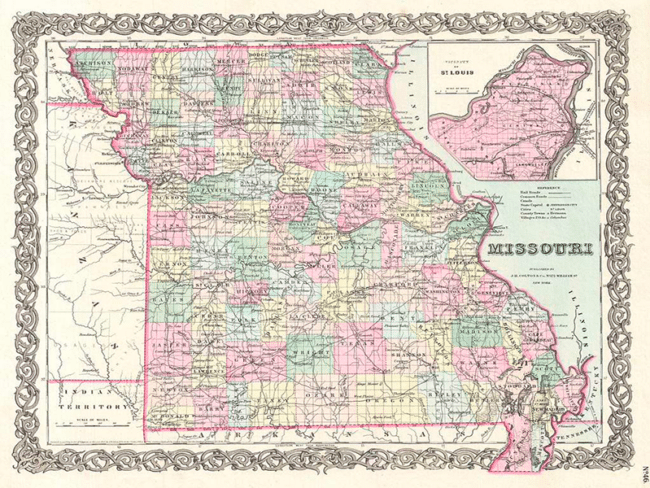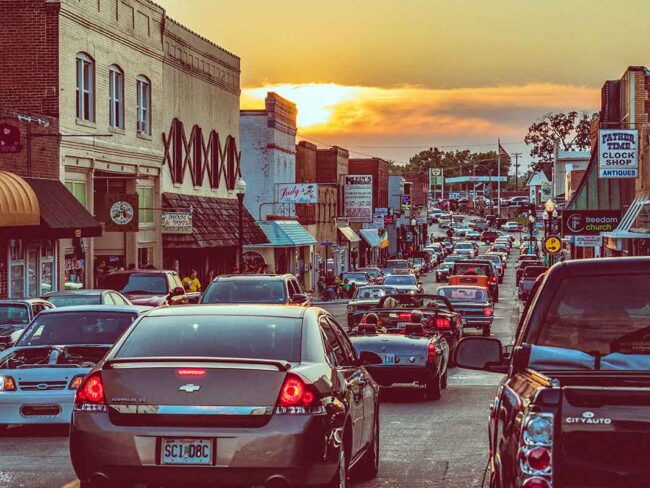There’s more to a visit to the barber shop than a simple shave and haircut. Get to know the barbers who are honoring their predecessors but also adding new services, amenities, and programs that appeal to the next generation of customers.
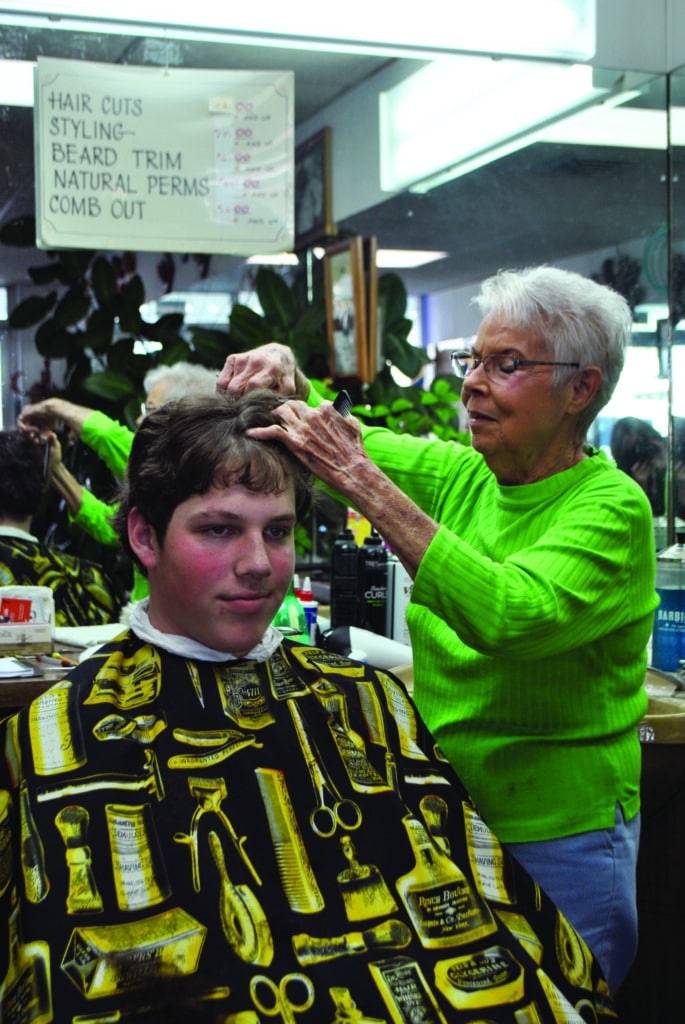
Story and Photos by Susan Atteberry Smith
When Missouri Life featured Newtonia’s Ted Arnall in a 1973 story, he had been cutting hair and telling tales in his small-town barber shop for 62 years. Fifty years later, Ted and his shop are immortalized on a mural in Newtonia, and the qualities he embodied of providing good service for a fair price ($1.25 for a haircut back in ’73) live on in the barber shops we visited for our 50th anniversary update.
It’s Noah West’s third visit to Robin Rader’s barber shop in the southwest Missouri town of Marshfield, but it’s the first time the sixteen-year-old has heard the story of Victor the wrestling bear, one of Robin’s visitors some 40 years ago. Yes, a 650-pound Alaskan brown bear once lumbered into the shop.
“It was so funny,” says Robin, remembering the bus that pulled up in front of Rader’s Barber Shop and Natural Hairstyling. “This guy came in and he stood there. And he said he had somebody else out there he needed to get in for a haircut.”
The bear’s trainer was kidding about getting Victor’s mane trimmed, of course. Still, he brought Victor inside long enough to pose for a photograph that still hangs above a mirror at the shop: It shows Robin with her scissors poised to clip a hank from the gigantic bear’s fur as he faces away from the four-foot-nine barber like an ordinary customer.
It’s still quite a story to tell her customers—and barber shops like Robin’s are full of those. Fifty Missouri barbers have closed their doors over the past two years, according to the Missouri Board of Cosmetology and Barber Examiners, possibly because some weren’t able to recover after the pandemic. Nevertheless, 1,100 locations were still open in February, board statistics show—and the number of licensed barbers has grown by more than 200 to 3,060 since November 2021.
One Missouri barber speculates that the demographic driving a demand for barbers’ services is the same one that collects tattoos and vintage typewriters.
“What really made our industry come back was the hipsters,” says Tim Keele, whose Two-Bit Barber Company in downtown Sedalia offers old-fashioned, straight-razor, hot-lather shaves with a beer and cigar to a younger generation with a new appreciation for such luxuries.
Indeed, the 44-year-old got a tattoo of a straight razor with a “K” for Keele to celebrate his barber school graduation in 2017. Lists of services at shops may have changed in the four decades since Robin trimmed a wrestling bear’s mane in Marshfield, but not the listening ears and sense of community that many barbers—and their neighborhood locations—provide.
STILL TRUE TO THE TRADITIONS
From basic shaves and haircuts to stylish fades and artistic lines, services among even a small sampling of Missouri shops vary widely. Despite a few unusual customers, Robin has kept things simple for 44 years. After working as a barber in California for 14 years, she moved back to her hometown in 1978 with her husband and opened her shop on the west side of the square. “Natural hairstyling,” Robin explains, means she does shampoos, haircuts her customers can easily maintain, and shaves—although, she adds, she will also pick out perms for customers.
While Robin’s appointment after Noah happens to be a woman needing a trim, the straightforward proprietor says that offering services typically popular among women makes little business sense to her.
“When I’m done with him,” she says of Noah, “he gets up and he leaves. If I was doing a woman, she’d sit over here in the dryer for 45 minutes, and I’d have to do her again”—meaning the styling process would put that customer right back in her barber’s chair for even more time.
On the mirror behind that chair, prices are straightforward, too, and still low. About two years ago, Robin finally started charging $12 instead of $8 for a cut, after a longtime customer urged her to raise rates.
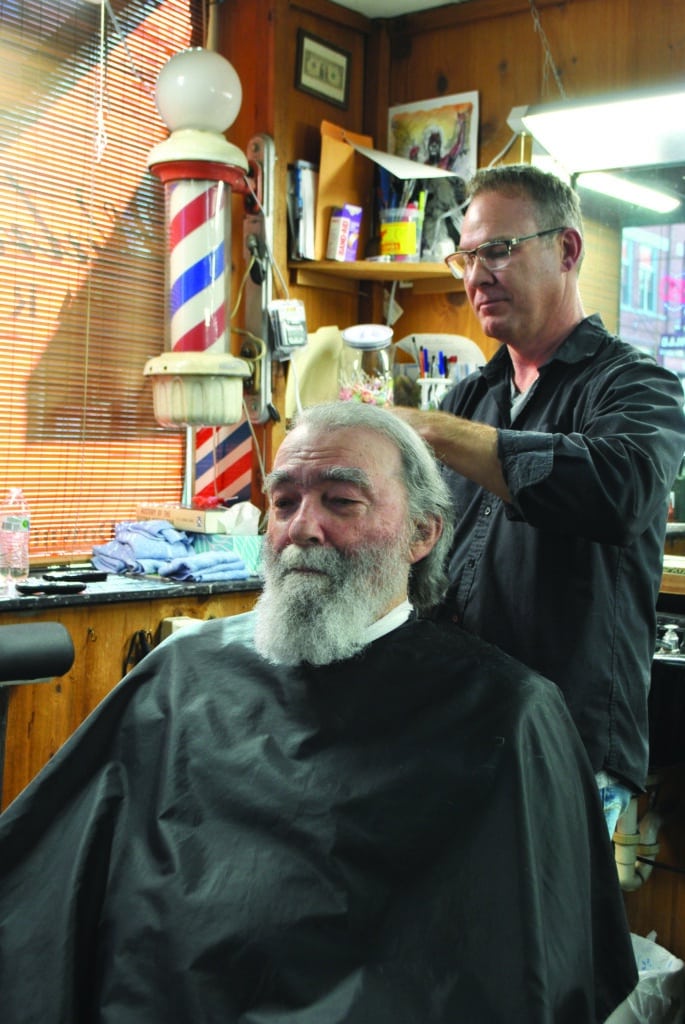
Change also comes slowly—or not at all, if regulars have their way—at Walnut Street Barber Shop, a downtown Springfield fixture since 1943 in its 19th-century building. Customers can request everything from buzz cuts and fades to specialty cuts like Mohawks, yet the shop’s decor is stubbornly old-school, boasting its original wood paneling.
Local writer and musician Michael Cochran has been walking in off the street for haircuts for at least 30 years, signing in at a book on a stand, then sitting down to wait in one of the padded office chairs lined up against one of the paneled walls. The shop’s three barbers work fast, so he doesn’t have to wait long.
“All those other places try too hard,” he says with a chuckle, as shop owner Russell Gann cuts his hair and trims his beard. “I just love this place.”
Russell’s father, John, was Michael’s barber when he first started coming there. In 1994, when John Gann bought the shop, he might have been only the second or third owner among its longtime barbers in 50 years, although Russell says he isn’t sure, adding, “It seemed like these old guys kind of traded it around a bit.”
Even when Russell started working alongside his father a year after John took ownership of the shop, two of the shop’s original barbers would still stop by from time to time. Russell bought the business from his dad in 2000, and he says the die-hard attitudes of his predecessors live on among some of their younger counterparts in the barbering business.
“The biggest change I made when I took over was I put in a TV,” Russell says. “The old guys didn’t like the TV. They thought it was a distraction.” Russell kept the TV. However, he and his wife, Amy, also a barber and co-owner of the shop, don’t plan to make significant changes. “I don’t think I need to,” he says matter-of-factly. “It works, and I like it.”
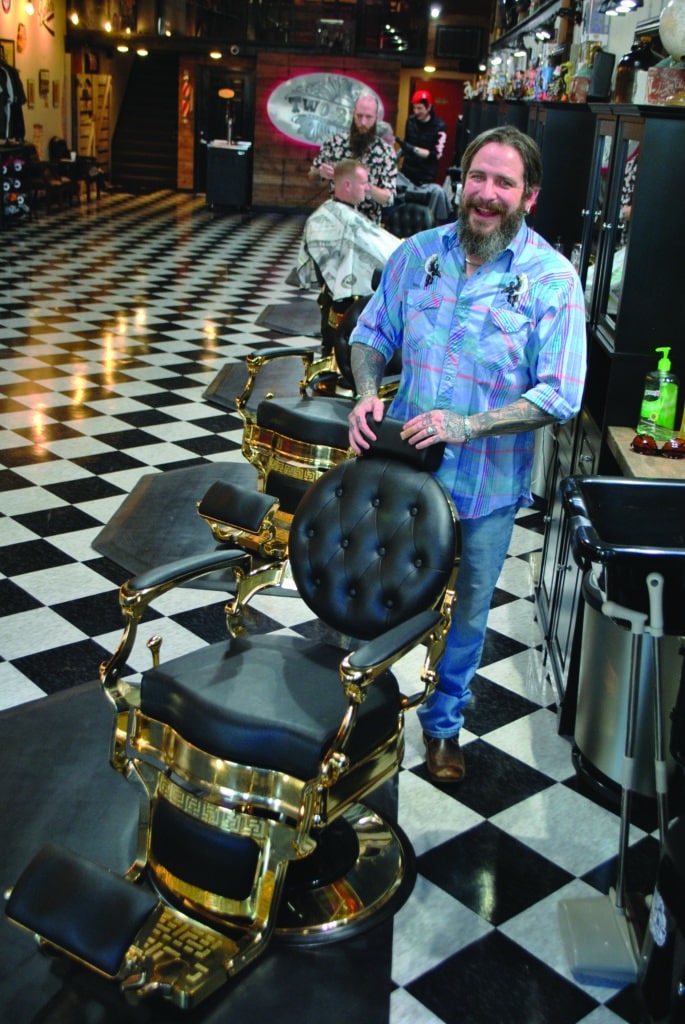
RETRO SHOPS, MODERN TWISTS
Meanwhile, in Sedalia, there’s more than one “distraction” at the Two-Bit Barber Company, where big-screens keep customers up-to-date on their favorite sports teams. However, in an 1883 building that once housed a pharmacy and soda fountain, the shop across from the Pettis County Courthouse also tips its hat to a distant past.
Gutting the building before he opened the shop in 2018, Tim kept its brick walls exposed and original black and white checkerboard floor intact. Gold-trimmed chairs add to the retro feel. So do Two-Bit’s services. A Sedalia native, Tim says he wanted the shop to be a “throwback to traditional barbering, the lost art”—and that’s why haircuts and hot-towel and straight-razor shaves can be purchased along with a beer and cigar.
In February, barber Dillon Edens fashioned a fade for customer Chad Lance, a Marshall resident who regularly makes the 26-mile trip to the shop.
“Every time I come here, I look forward to a fun experience,” Chad says. “You can have a great haircut, you can have a beer and cigar, and great conversation.”
One hundred miles northeast in Moberly, providing services in demand among younger generations is also important to Bud’s Barber Shop owners Shelby Mares and Stephanie Schupp, yet so is paying homage to the shop’s heritage.
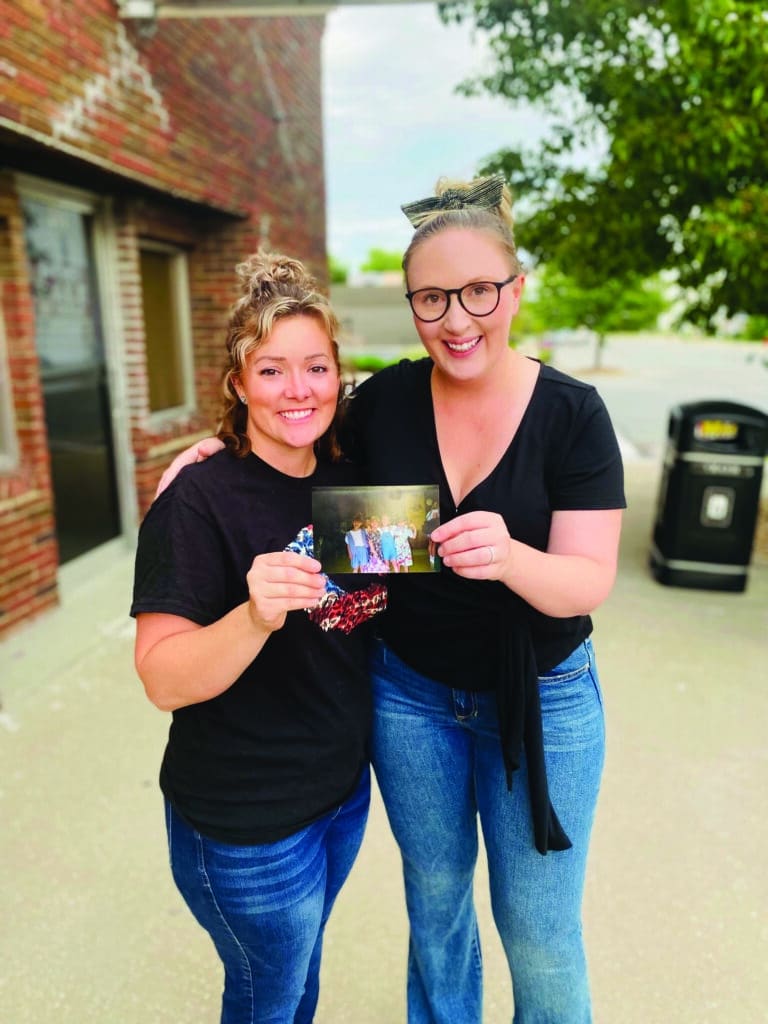
Friends since they were preschoolers, the hometown daughters, now both 31, reopened the shop last fall, two years after the original proprietor died. Before he retired in 2019, Lester “Bud” Prewitt had owned and operated the downtown business—then called Bud’s Barber & Style Shop—for 47 years.
Stephanie described Bud as “a long-time staple” in Moberly. She is a real estate investor and heard last summer that the shop was for sale. She was eager to bring Shelby, a cosmetologist, on board as a business partner. Shelby also had a family connection to the shop: Her husband, Adam, was Bud’s nephew.
During their renovations last fall, they painted paneling and built stations with doctor’s cabinets from an old office upstairs. They kept Bud’s original chair and sign. While the shop prides itself on attracting a diverse new generation of customers with an expanding menu of services, they still serve all of Bud’s old customers, says Shelby, who is studying to add the title of barber to her business card so that she can offer the popular straight-razor shaves, too.
“Our idea was to keep Bud’s memory and barber shop alive but to kind of put a modern twist on it,” Stephanie says with reverence for the former owner. “It’s been an honor to keep the business going.”
A LEGACY WORTH PASSING FORWARD
Some Missouri barbers chose the career early in life. Nearly 60 years ago, barber training was a birthday present to Robin and her brother, Bill Lineberger, from an uncle who owned five barber schools in the state of California. And back then, she says, she didn’t think about herself as bucking the stereotype of males as barbers—even though she dubs herself the “Lady Barber” on business cards.
“Of course, I never really thought about it because that’s what I wanted to do. And I really didn’t care,” she says.
As a teenager, Russell didn’t necessarily plan to follow in his father’s footsteps, yet at age 20, he decided to go to barber school and now, at 49, he hasn’t looked back. Working alongside his father was fun, he says, and barbering is “the only thing I’ve ever done.”
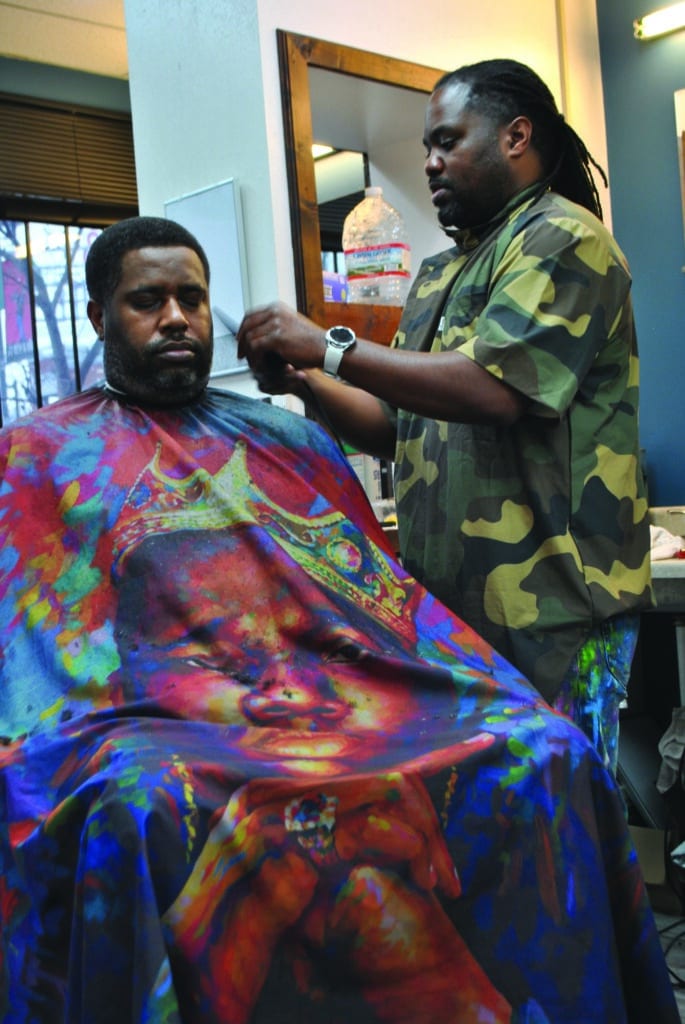
The story of Joseph “Joey” Thomas, owner of 180V Barber Salon near 18th and Vine in Kansas City, began differently. Doing hair runs in his family, too—his mother, LaDonna Adams, is a Kansas City cosmetologist—yet as a teenager Joey dreamed of studying at the New York Film Institute.
“Yeah, I wanted to be like a mix between Ice Cube and Spike Lee,” he says.
Unfortunately, financial setbacks kept him home in Kansas City to help out, then led him to barber school. After 20 years as a neighborhood barber, though, he says he’s grateful his career path changed. Hearing customers talk about the needs of his community—first at his shop about four miles south of the Jazz District and now at his shop in the historic Lincoln Building—inspired him to start the Know Joey? Foundation in 2007.
At Thanksgiving, he and other volunteers donate turkeys to under-served families through the foundation’s Turkey Tuesday program. Through the Fresh Cut Fresh Start program, they offer free back-to-school haircuts for boys and young men.
Friends since preschool, as the old photo they display attests, Shelby Mares (left) and Stephanie Schupp bought the Moberly staple Bud’s Barber & Style Shop—now Bud’s Hair Lounge—in 2022. The duo continues to serve Bud’s longtime customers and have added new services.
“God blesses you; you want to bless others,” the 39-year-old says.Joey considers the foundation a ministry that depends on others—and God puts those people in his life, too, he says. “I don’t cut 200 heads by myself,” Joey says of the free haircuts his shop donates. “The turkeys that we give away, I don’t go out and buy a thousand turkeys, you know.”
Solitude is seldom penciled into appointment books, particularly for barbers with close community connections built on acknowledgement and trust.
“Everybody in the world wants to be recognized when they go somewhere often, especially if they’re spending their hard-earned dollars,” says Tim Keele of Sedalia’s Two-Bit Barber Company. “They talk to you about personal things, funny things.”
Robin says she makes sure to pay attention to the news so she has topics to talk about with customers. When Wilma Cardwell sits down for a trim at Rader’s Barber Shop, Robin praises her friend and loyal customer’s unwavering support of Marshfield High School sports teams.
They’ve discussed deeper subjects, though. “She’s just good to talk to, easy to talk to,” Wilma says of Robin, “and I don’t think she’s one that takes it somewhere else. It stays with her.”
“Yeah, it stays here,” Robin agrees.
Back in Kansas City, Joey speaks of the trust that develops between barber and customer. He jokes, “Anytime a man is willing to let you put a razor on his neck and he falls asleep, that means he’s got a lot of trust in you.”
Being a barber “comes with a level of responsibility and accountability,” he says, “because the clients confide in you. They tell you stuff that you literally have to take to your grave.”
NEVER A BAD (HAIR) DAY
In return, barbers often play a role in the most meaningful moments of their customers’ lives, from job interviews and weddings to funerals. Joey gave a customer’s son his first haircut, then sold him his first car years later.
In Springfield, Russell has had similar experiences: “A lot of the people who grew up getting their hair cut here are bringing their kids in now,” he says.
Robin doesn’t have children of her own, yet she has cut the hair of generations of families. “I don’t have any kids other than 58 years’ worth of kids I’ve had in the barber shop,” she says.
Around Marshfield, longtime residents know that some of her “kids” have also been the canine companions she has had over the years, including a 220-pound mastiff named Max. Max was a therapy dog who was only a foot shorter than the petite barber yet weighed twice as much, and one of Robin’s favorite stories is about the local pawn shop owner who once fitted Max with a saddle for a parade.
Over the years, Robin has held other jobs while working as a barber, yet even at 80, she has no plans to close the doors to her shop and advises others to do work they enjoy as much as she has enjoyed hers.
“If you don’t like what you do, get another job,” she says, “because you’re at work more than you’re at home.”
In only six years of wielding scissors, Tim agrees, noting that less than satisfying moments in barbering rarely last longer than one appointment. “I wish I would’ve done it 20 years ago,” he says. “This is one of the only careers I can think of that you never have a bad day.”
A Cut Above • Missouri Life Magazine
Article originally published in the June 2023 of Missouri Life.
Related Posts
Missouri Counties Formed
On January 2, 1833, new Missouri counties, including Carroll, Clinton, Greene, and Lewis, were formed on this date.
108 Missouri Wineries
On December 11, 2012, state officials announced that there were now one hundred and eight commercial wineries operating in Missouri.
Revitalizing Missouri Downtowns
Here’s how Missourians are working together to revitalize downtowns across the state.

